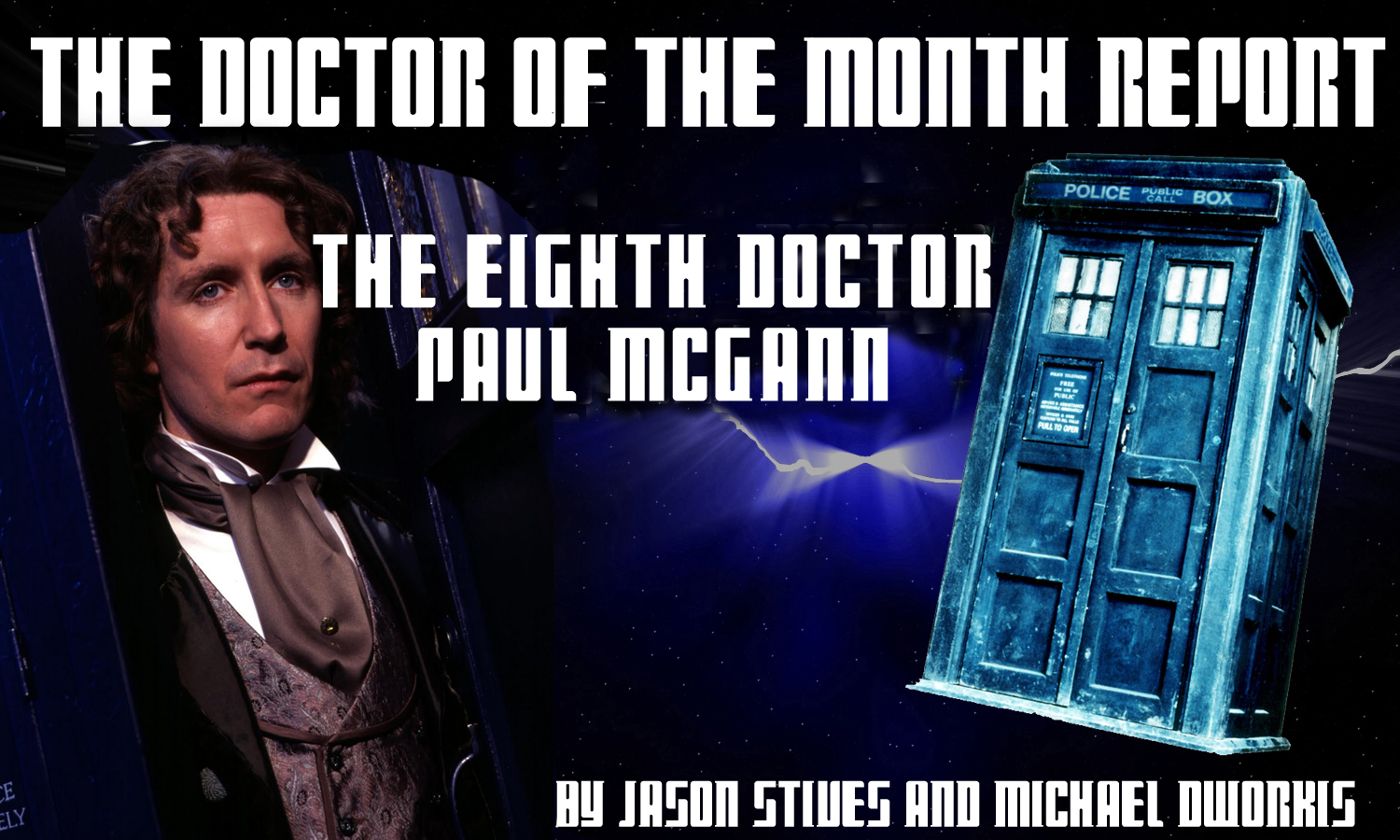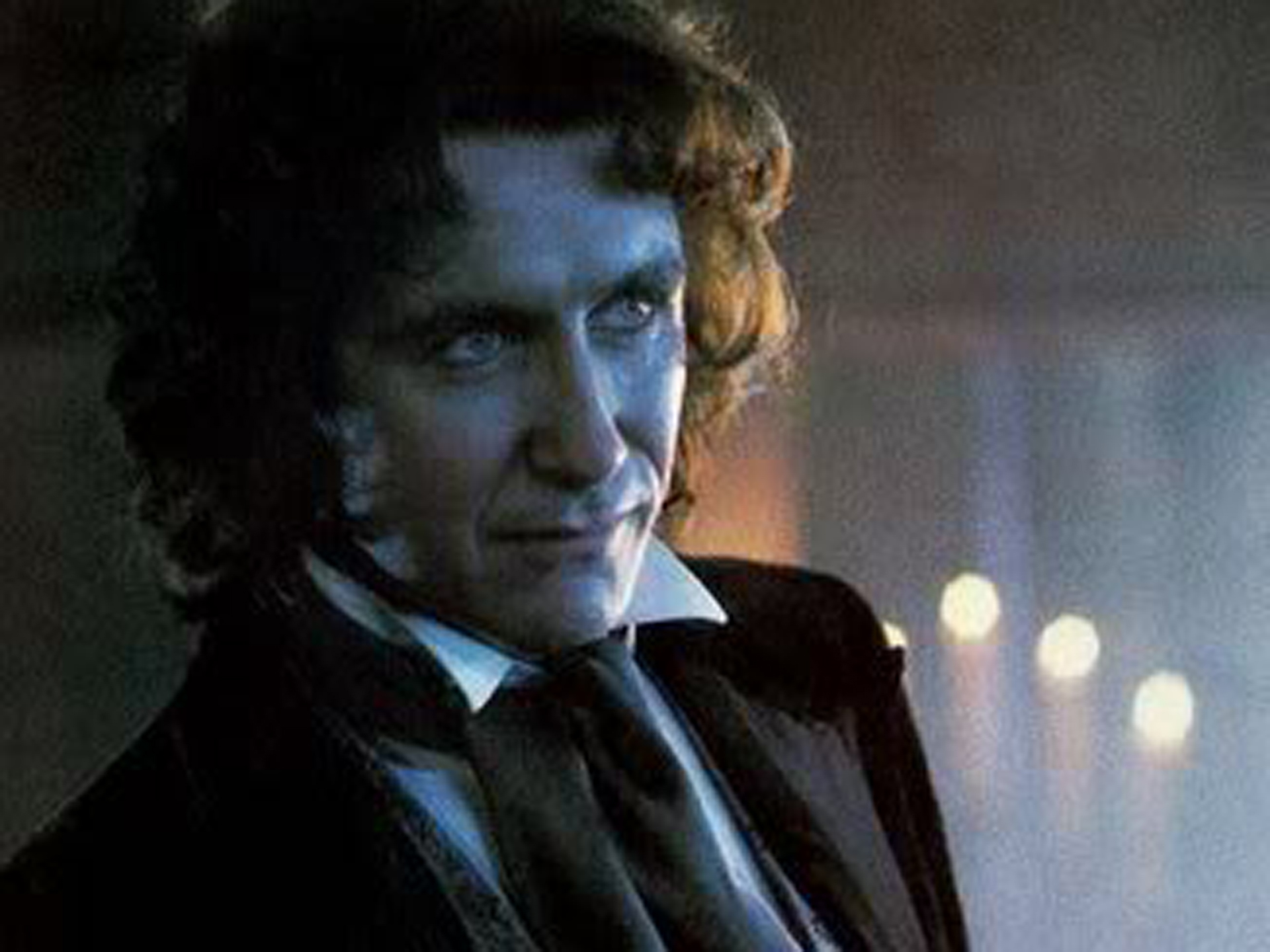jason stives looks at the eighth doctor who, who only appeared in one made for tv film…
Profile:
While his sole appearance on television leaves much to be desired, the combination of the BBC book range and the Big Finish audio adventures paints a very elaborate picture of the Eighth Doctor. In the movie, Paul McGann’s Eighth Doctor is portrayed with having Dickensian-like qualities with a penchant for pick pocketing. He can also be seen giving away hints about peoples’ futures, possibly as a way of getting them to make right decisions and telling them to seize their lives. His rugged and youthful looks took the Doctor out the middle aged thinking man and into an adventurous and action oriented persona. The Doctor could be seen tangling one on one with The Master, climbing down fire escapes, and riding a motorcycle through oncoming traffic.
He is also the first Doctor to engage in any romantic activity as he is seen to kiss his film companion, Doctor Grace Holloway on several occasions, normally out of excitement and curiosity than actual love interest. Still, this added a more humane dimension to The Doctor that had never been explored before on television. In the original novels, however, this idea was repressed and the Doctor normally found himself the object of attraction rather than showing interest of his own. The Eighth Doctor also has a pension for amnesia, first displayed here after his initial regeneration and explored further in the BBC Book range of original Eighth Doctor adventures. He wears a very Edwardian outfit, complete with a frock coat, cravat, and silver waistcoat. He dawns the outfit after sifting through the contents of the staff locker room at the hospital he is interned at.
Significance/Influence:
The trouble with examining the short life of the Eighth Doctor comes down to two things: 1.There is only one visual adventure that can be judged and 2. Depending on who you ask, it’s not a very good one. Indeed, the 1996 TV movie dubbed in some circles as The Enemy Within has many flaws in presentation that are both inaccurate to established Who canon and confusing to potential new fans. Instead of starting from scratch in explaining the origin of the is strange man, the movie was a direct continuation from the cancelled television show, with the Seventh Doctor starting out the movie before being mortally wounded 30 minutes in and regenerating into his eighth incarnation. For many within the BBC this was a sour choice as they had very few fond memories of Sylvester McCoy’s time on the show, and from a narrative end, starting out a movie to a new audience where your hero fails at the start doesn’t instill much trust and interest in the main character.
A little background on the TV movie’s journey to our screens: As the show’s original incarnation was winding down, an enthusiastic producer from the United States named Phillip Segal, who at the time was working as producer at ABC, was in hot pursuit of acquiring the Doctor Who property for a new series in conjunction with an American network. At the time, however, Doctor Who was being outsourced for a potential movie, with a generic production company named Coast to Coast holding onto the film rights. The movie negotiations went neck and neck with Segel’s ambitions for a solid seven years, at one point Hollywood legend Donald Sutherland was touted to play The Doctor and the film was to be directed by Mr. Spock himself, Leonard Nimoy. These attempts eventually went nowhere, giving Segal free reign to work closely with the BBC about bringing production of a new Who stateside. Interesting fact, Segal’s boss on the NBC show Sea Quest: DSV was Steven Spielberg, who showed great interest in having his Amblin Entertainment production company act as a producer on a new series as he was quite aware of Doctor Who and still is. “The world would be a poorer place without Doctor Who,” he said during the press junket for The Adventures of Tin Tin, of which current DW executive producer Steven Moffat served as a writer on.

After trying hard to shop a potential new series in conjunction with the BBC around to various networks, the series turned into a backdoor pilot based at the Fox Network’s TV movie department, with the potential for series pickup if successful. Numerous changes took place behind the scenes including multiple script rewrites and the exit of Spielberg from the project after the script he read was deemed too similar to Indiana Jones. Despite Mr. Spielberg’s absence, the production press forward, with many highs and lows through its 30 day shoot.
Many parties involved had their own ideas and requests that found their way into the finished product. Some ideas, like the inclusion of a famous American actor in the role of The Master, were done in exchange for the casting of the unknown McGann as The Doctor. When the movie debuted in the UK in May 1996, it scored record ratings and was warmly embraced despite fan musings about the content. In the United States, however, the show was scheduled opposite the last ever episode of Roseanne and performed poorly in the ratings, and no further installments were pursued. Despite it being his only association with Doctor Who, Philip Segal went on to become a very important producer in the reality television genre serving as executive producer and creator on shows such as Deadliest Catch, Ice Road Truckers, Storage Wars, and the soon to be ending 1000 Ways to Die.
Despite a poor response by many fans, the TV movie explored many aspects that the new series took vestige in when the time came. Production wise, the increased budget of the TV movie created some wonderful action sequences, stunning visual effects, and a gorgeous TARDIS console room in the vein of HG Wells, giving new life to the stuffy theater like production the show had been use to.
However, not all elements were embraced, the obvious being the notion that is implied here that the Doctor is half human, on his mother’s side no less. This has been completely dropped in current Who and was almost joked about during David Tennant’s swan song in 2010 in which the Doctor would’ve joked that he was human for a night back in 1999. Regardless, the dramatic and cinematic feel of the TV movie is clearly the way the show is handled now making the legacy of Doctor Who more than just shoestring budgets and wobbly sets, but fun adventures with strong stories and acting behind them.
Essential Stories:
Beyond the TV Movie, of which I will discuss briefly below, I would recommend venturing into some of the BBC book range of Eighth Doctor stories if you can find them on Amazon, as well as some of the Big Finish audios that feature him. They are a more comprehensive telling of the Eighth Doctor and create a far more decorative timeline for this incarnation from what is only hinted at in the TV movie.
Doctor Who- The TV Movie
The Doctor is sent to the planet Skaro to retrieve the remains of his old enemy, The Master, after he has been put on trial and exterminated by The Daleks. Upon returning to Gallifrey with his remains, the TARDIS goes into a state of temporal influx brought on by The Master’s presence and is forced to land in San Francisco on the eve of the Millennium in December 1999. The Master escapes, a bit in the form of a serpent like apparition, and upon exiting his ship, The Doctor is struck down by gun fire from a rival gang war. He is taken to hospital where he is operated on by a surgeon named Grace Holloway, who knows nothing of the Time Lord physiology. The result, The Doctor dies on the operating table only to regenerate into his Eighth incarnation. Now suffering from amnesia and aided by the woman who basically killed him, The Doctor must stop The Master, who is now in human form and in control of his TARDIS before he uses the events of the new millennia to destroy the planet.
Doctor Who: The Movie suffers many issues in presenting itself to a new audience, mainly an overload of continuity from the original series. In the first 20 minutes alone you are told of things like Daleks, timelords, The Master, and regeneration, under the notion that you already understand what these are. While I commend the production team for trying to link it to its roots, a new audience can’t conceivably understand what is going on at this point and the narrative sadly is a mess. Beyond a great performance from McGann, the movie suffers from the over the top performance of Eric Roberts as The Master, here in the guise of an ambulance driver. Roberts is basically chewing scenery with good intent but is completely acting against the character of the Master, playing him more like a super hero villain than the Moriarty of the Doctor Who universe.
The story is also a bit bland as the main plot point involves The Master trying to suck humanity through the eye of Harmony, a device deep within the heart of the TARDIS that harnesses the energy of the time vortex. It’s not that ingenious but the film is not as a horrid as some people make it out to be.
All Photos Credit: BBC






